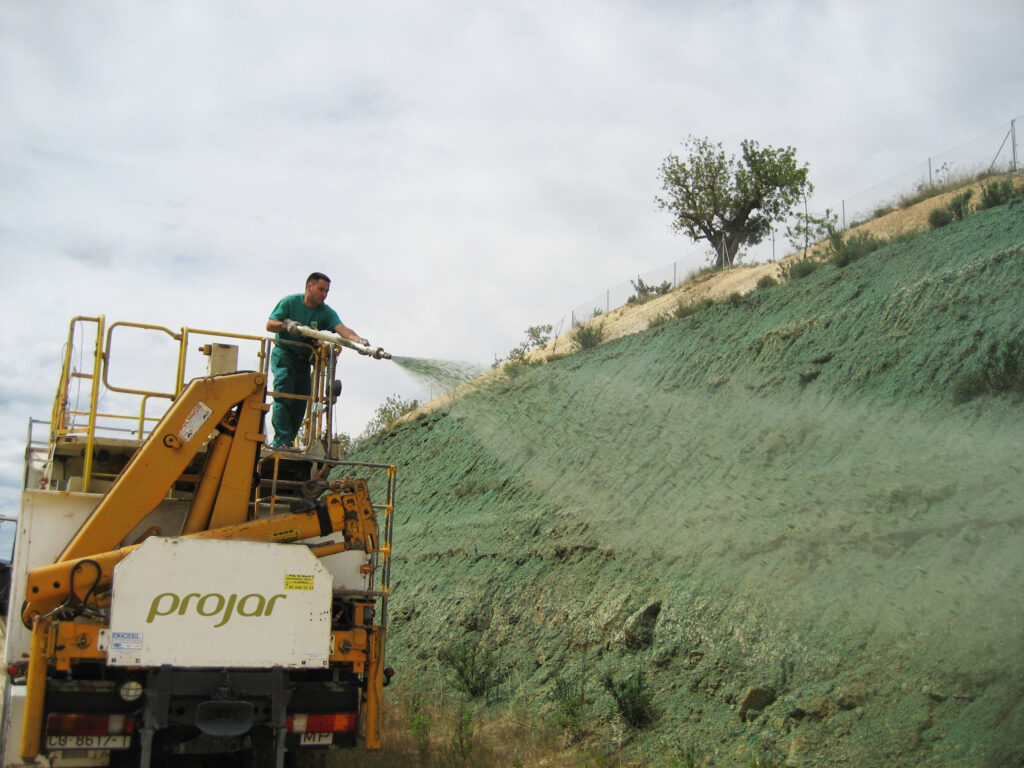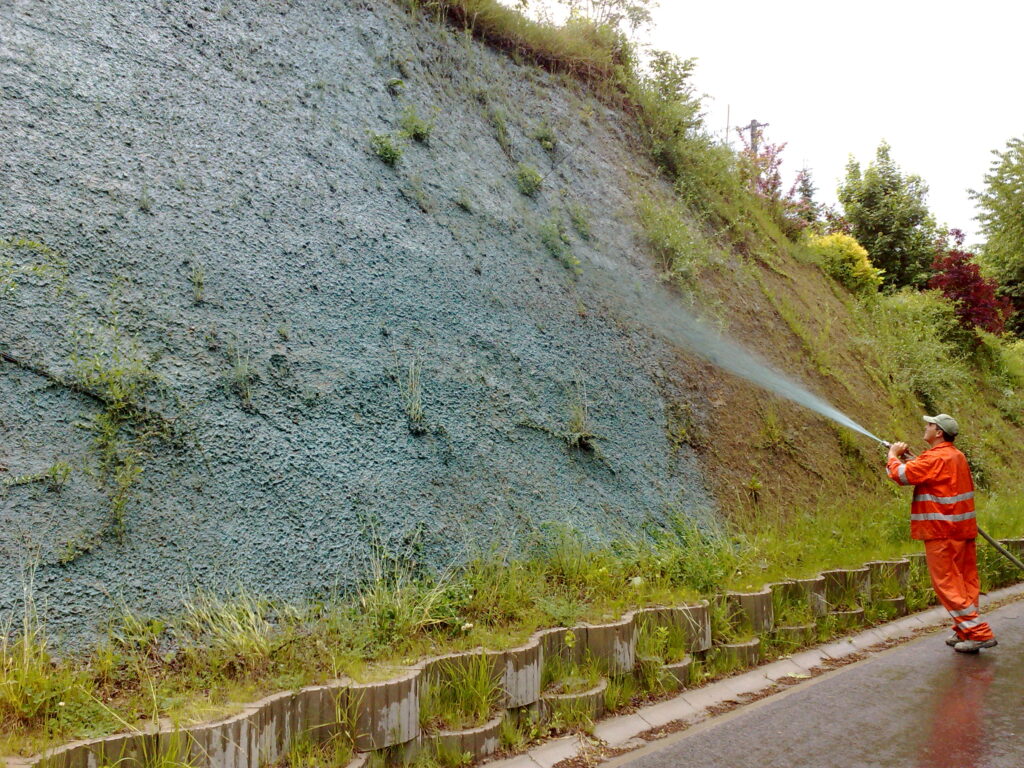Hydroseeding

Hydroseeding, or hydromulching as it is also known, has probably come across your radar if you’re looking for a quick and efficient way to seed a sizable area, get a lush, green, and healthy lawn, or re-establish vegetation in an area that has been disturbed by construction activities or wildfires.
Hydroseeding is quick, inexpensive, and produces dependable, repeatable results.
How does Hydroseeding work?
To stop soil erosion and provide a favorable environment for plant development, hydroseeding includes spreading an uniform slurry of water, seed, wood fiber mulch, and soil stabilizing tackifier across a surface. When no seed is added to the slurry, the procedure is known as hydromulching. A truck-mounted tank with a specific pump and continuous agitation system is used to apply these mixes. The slurry is pushed up to 300 feet by a top-mounted discharge nozzle or by hose.
This process coats the soil with a barrier that prevents erosion while fostering the best conditions for plant development. By reducing soil disturbance and aiding in moisture retention, hydromulching and hydroseeding support healthy soil. For strong, wholesome plants, the Hydroseed mixture can also be supplemented with additives like mycorrhiza fungi or organic fertilizer.
Benefits of Hydroseeding
- Provides a layer of erosion prevention using organic glue and wood fiber mulch.
- Cost-effective method for large-scale or challenging-to-access sites
- Can be used on steep slopes with little disruption to the soil.
- Even on steep slopes, a consistent seed mixture remained in place.
- Maintains moisture to promote the germination of seedlings that have been planted or that already exist.
Applications
- Permanent or temporary erosion control measures
- Turf planting
- Alternatives to lawns made of local grasses
- Planting meadows and wildflowers
- Spreading tackifier and seed are spread over rice straw or nets

How to care for Hydroseed
Making ensuring your hydroseed has the highest chance of success requires knowing how to properly care for it. Here are a few best practices to follow in order to ensure that the seeds are strong and have a solid base on which to grow.
SCHEDULE FOR WATERING NEW HYDROSEED
Understanding how to properly water new hydroseed is essential since moisture content affects how quickly and successfully seeds take root and establish themselves. Setting up a regular watering routine for fresh hydroseed is a good approach to keep consistent moisture levels, and the first two weeks after hydroseed application are particularly crucial.
After the initial hydroseed treatment has dried, which usually takes place over night, start watering the area. To prevent oversaturated regions, water using a light spray setting on a hose. Similar to this, while using sprinklers, make sure the area is evenly covered by the spray. Also, keep an eye out for any spots where water may be pooling and make any necessary adjustments.
After hydroseeding, a basic rule of thumb is to water the area for roughly 10–20 minutes, 2-3 times each day, depending on the local weather. If the climate is warm, but not extremely hot, and dry, this can occasionally be lowered to every other day, or every day if it’s cooler and the ground is naturally more wet. You can forgo watering if there is enough precipitation to keep the land evenly moist.
The most important things to keep an eye out for are not letting the area dry up in between waterings and not drowning the seeds by overwatering.
HYDROSEEDING AFTERWARDS: WHEN TO MOW
Prior to cutting your freshly hydroseeded lawn for the first time, wait until the grass is between 3″ and 4″ high. Normally, this takes 3 to 4 weeks. Depending on the type of seed, the climate, and the current temperatures, sprouts can normally be seen 7 to 10 days after sowing.
at encourage growth and assist the grass fill in any areas that haven’t taken hold as well as others, make sure your mower is also set at the proper height to only remove the top 13 of the grass.
FERTILIZER
After applying the hydroseed, wait around 30 days before adding more fertilizer. Pick a period when the grass is comparatively dry, and after applying fertilizer, thoroughly water the area. Look for starter fertilizers, slow-release fertilizers, or fertilizers that are well-balanced that are designed for fresh grass. Additionally, be sure to read and abide by the suggestions in the fertilizer’s application instructions before using it. After establishing, you can typically fertilize your new lawn once per season, excluding the winter, or roughly three times per year.
WEED CONTROL
For at least 3–4 months, refrain from applying any weed killers or herbicides on your just hydroseed lawn. Prior to implementing any weed control measures, you should give the grass plenty of time to establish. When the grass is well-established and has grown in well, you can choose a weed control solution made specifically for new grass.
FAQ'S ABOUT HYDROSEEDING
Yes. New grass can be planted and established safely, non-toxicly, and effectively with hydroseeding. Hydroseeding is safe to use around kids and animals because it doesn’t involve using any harsh chemicals.
In general, hydroseed won’t wash away after application if the soil has been adequately prepared and is not compacted. However, if the soil has not been de-compacted or otherwise prepared, it is possible that severe rains could partially wash away seeds if they fall right after hydroseeding has been finished. Tackifiers can lessen the possibility of the seed washing away.
It’s best to avoid using a freshly hydroseeded lawn for around 5 weeks, or until the grass takes root. Keep pets and wildlife away from the area as much as you can. A mesh fence or other barrier can help stop any unwelcome foot traffic in the area, at least until the seeds can take root.
Although this is largely weather dependent, new hydroseed can only go without water for one day. Maintaining moisture in newly planted hydroseed is essential for promoting germination and root growth, which will eventually result in a lush, green lawn. You might not need to water it completely or be able to skip a day or two if the weather is chilly and damp, like in the spring, but you should still check the area daily to make sure it is suitably moist.
Hydroseed germination typically takes 5 to 7 days. The type of seed and the climate affect germination time, thus if the weather is mild and damp, germination might proceed more quickly. On the other hand, germination will take longer than usual if the weather is dry and chilly. Usually, it takes 5 weeks to get a fully grown lawn that is able to be walked on.
The ideal seasons to hydroseed are often spring and fall, and each offers its unique benefits. The secret to a good hydroseeding is choosing a time that will be generally moderate and wet; by doing this, you’ll have as much support from nature as you can possibly anticipate to help you create a beautiful lawn. It is possible to hydroseed in the spring after the risk of frost has passed and in the fall before the first frost is predicted.
Plan to water new hydroseed for 10–20 minutes, usually 2-3 times each day. You want to make sure the new seeds remain continually moist, even if this schedule is also dependent on the weather. You might need to water up to four or five times each day in hotter, dryer weather, and less frequently in cooler weather. Monitor the weather and frequently scan the area for both dry patches and any places where water may be accumulating or pooling. If your yard has standing water, you may be overwatering it or having a drainage problem.
Generally speaking, hydroseeding over already-existing grass is not advised. It is more effective to utilize a technique called overseeding to fill in bare spots in an existing yard. A power rake and hand seeding are often used for overseeding. It is possible to hydroseed over established grass, but the slurry mixture must have the proper consistency to avoid killing the grass. This is frequently the main danger associated with hydroseeding over established grass.
Is Hydroseeding right for you?
To learn more about Hydroseeding and if this the right choice for you, give us call and we can answer anymore question you have and provide you with a quote for your project!
